Key takeaways:
- Smooth transitions in film are crucial for guiding audience emotions and enhancing storytelling effectiveness.
- Meticulous planning is essential for successful film production, fostering clear communication and creative execution.
- Utilizing techniques like visual motifs and sound design can create engaging and seamless transitions between scenes.
- Adaptability and openness to feedback are vital for overcoming challenges and improving one’s craft in filmmaking.
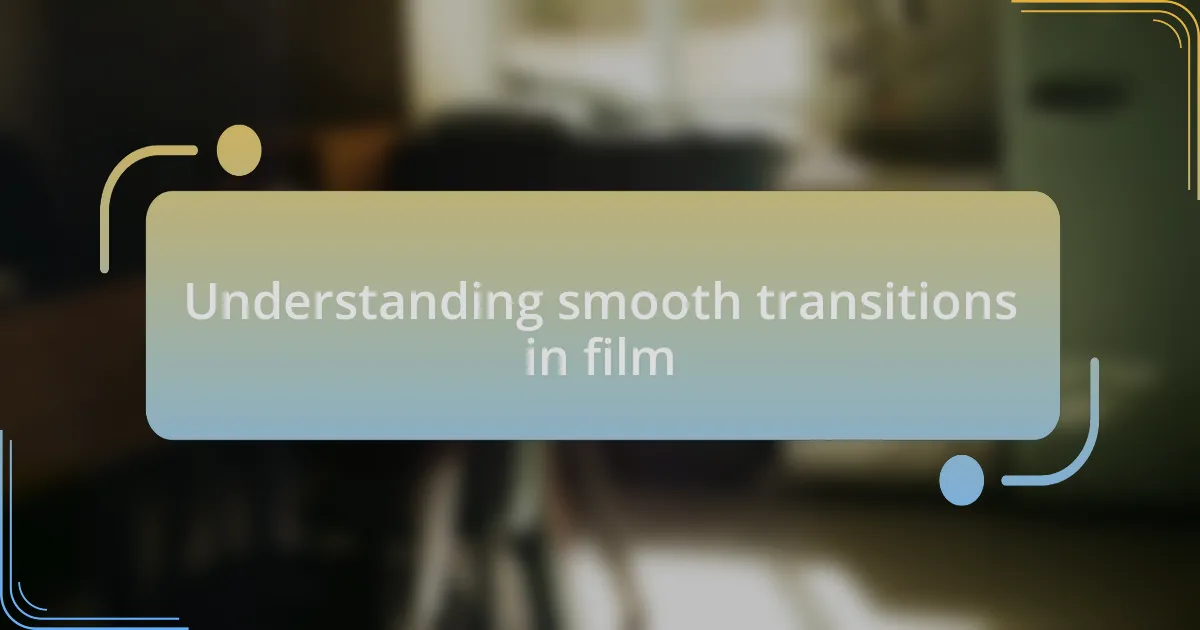
Understanding smooth transitions in film
Smooth transitions in film are not just technical elements; they hold the emotional weight of the story. I remember watching a classic film where a sudden cut from a joyful scene to a somber moment left me breathless. It got me thinking—how often do we consider the emotional journey a transition can create? Transitions have the power to guide the audience’s feelings, making them essential for effective storytelling.
In my experience, a seamless transition can elevate a film from good to extraordinary. I once worked on a project where we experimented with match cuts to emphasize the passage of time, and it was fascinating to see how the audience connected with the characters’ growth without feeling disoriented. Have you ever noticed how some transitions make you hold your breath, while others allow you to breathe easy? It’s all about pacing and the rhythm of the narrative.
Crafting smooth transitions often requires an intimate understanding of the film’s tone and the audience’s expectations. I’ve learned that what works in one genre might feel completely out of place in another. For instance, a quick, jarring cut might work well in a horror film to heighten tension, but in a romantic drama, it risks breaking the viewer’s emotional immersion. How do you think the choice of transition influences your viewing experience?
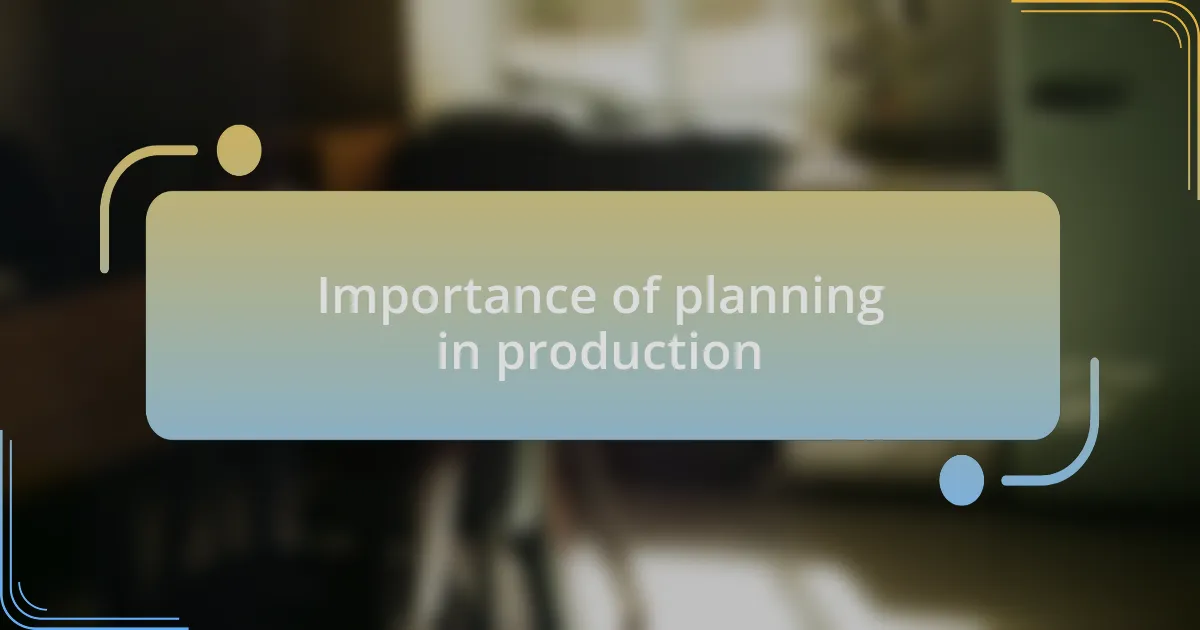
Importance of planning in production
Planning is a crucial aspect of film production that often gets overshadowed by the excitement of the shooting phase. I’ve found that dedicating time to map out every scene, including transitions, helps avoid chaos on set. Have you ever rushed through a shoot and later regretted not having a clear vision? I certainly have, and those moments taught me that meticulous planning can save you from costly reshoots.
When we take the time to plan, we create a shared understanding among the cast and crew about what needs to be accomplished. I remember leading a small team through a complex sequence that involved multiple locations. By outlining each shot and its transitions beforehand, we were able to execute it efficiently, leaving room for creativity when the cameras were rolling. Isn’t it empowering to know that a well-structured plan can free you to focus on artistic expression instead of scrambling to figure things out last minute?
Moreover, a solid production plan fosters better communication, ensuring everyone is on the same page. During my early projects, I often overlooked this aspect, resulting in confusion and misalignment. I learned the hard way that when crew members understand the intended emotional beats and transitions, they can contribute more effectively. How has effective communication—or the lack thereof—shaped your production experiences?
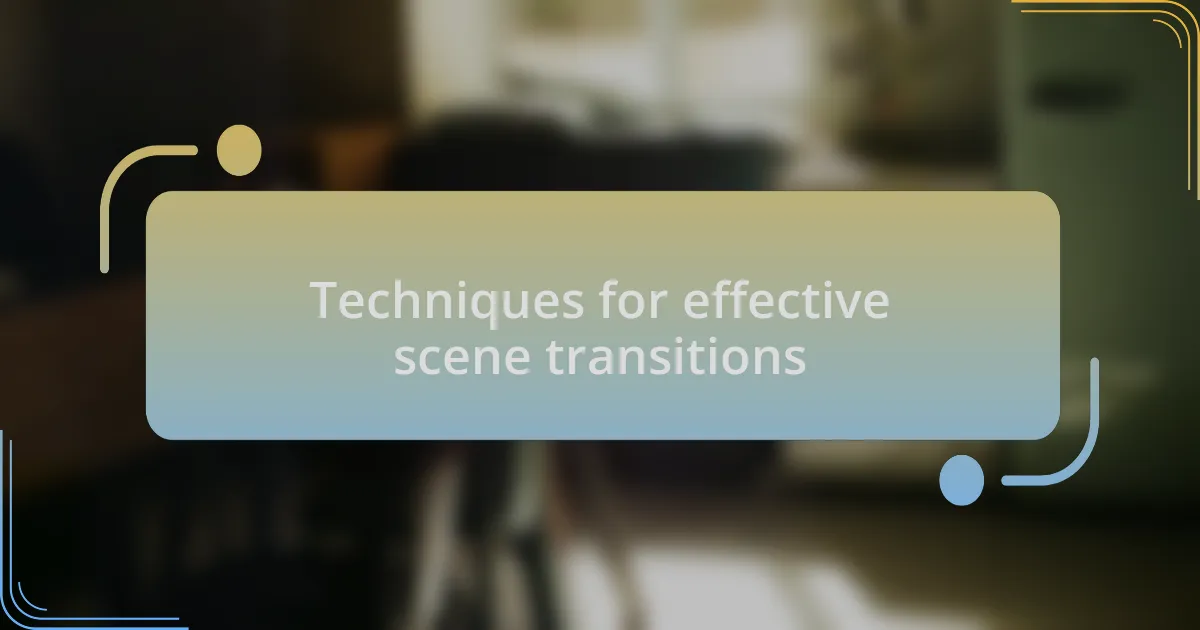
Techniques for effective scene transitions
When it comes to scene transitions, one effective technique I often rely on is the use of visual motifs. For instance, I once worked on a short film where I used a recurring image—a flickering candle. Each time it appeared, it signaled a shift in time or emotion. This not only created a cohesive visual narrative but also allowed the audience to intuitively grasp the story’s flow. Have you ever noticed these subtle cues in your favorite films?
Another essential approach I find invaluable is the match cut. I remember a project where we transitioned from a sunrise to a character’s eye opening. The seamless shift not only captivated viewers but also sparked deep emotional resonance. The continuity made the audience feel connected to the characters and their journey. Can you think of a match cut that left an impression on you? The power of such techniques is immense; they educate the audience while keeping the story engaging.
Sound design also plays a pivotal role in smoothing transitions. I’ve seen moments in editing where layering ambient sound created an invisible bridge between scenes. During post-production on a documentary, I once faded the sound of bustling city life into a quiet scene, drawing viewers into the next moment effortlessly. Doesn’t it feel incredible how sound can elevate your storytelling? That’s the magic of effective scene transitions—it weaves the narrative together, enhancing the overall viewing experience.
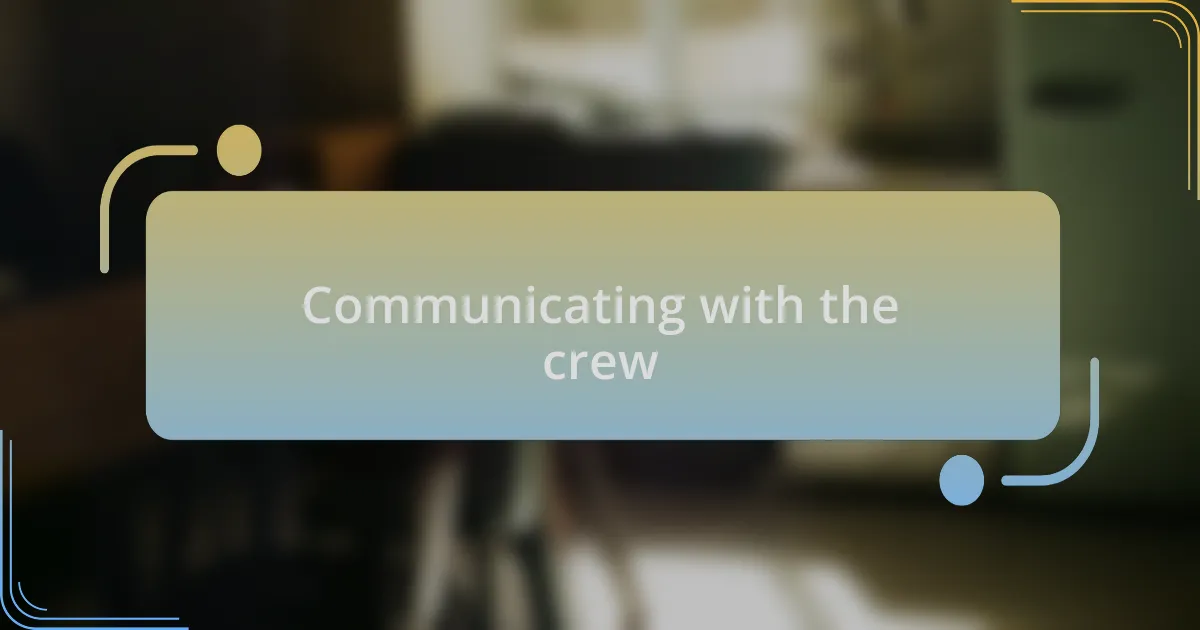
Communicating with the crew
Establishing clear communication with the crew is essential for a smooth production process. I remember working on a set where our first assistant director implemented a daily briefing. This simple yet effective practice kept everyone aligned on the day’s goals, and I found that it not only enhanced productivity but also created a sense of teamwork. Have you ever experienced the difference a quick team huddle can make?
Using visual aids has also drastically improved our communication. In one project, I created a color-coded schedule that visually represented each department’s responsibilities. It was eye-opening to see how quickly everyone could reference and understand their roles. It’s fascinating how something as simple as color can simplify complex information, isn’t it?
Lastly, I can’t stress enough the importance of an open-door policy. During my early days, I noticed that crew members sometimes hesitated to voice their concerns. Once I encouraged a more approachable environment, I was amazed at how many creative suggestions surfaced. This made our transitions smoother as everyone felt empowered to contribute. Don’t you think that fostering a dialogue can lead to unexpected gems in creativity?
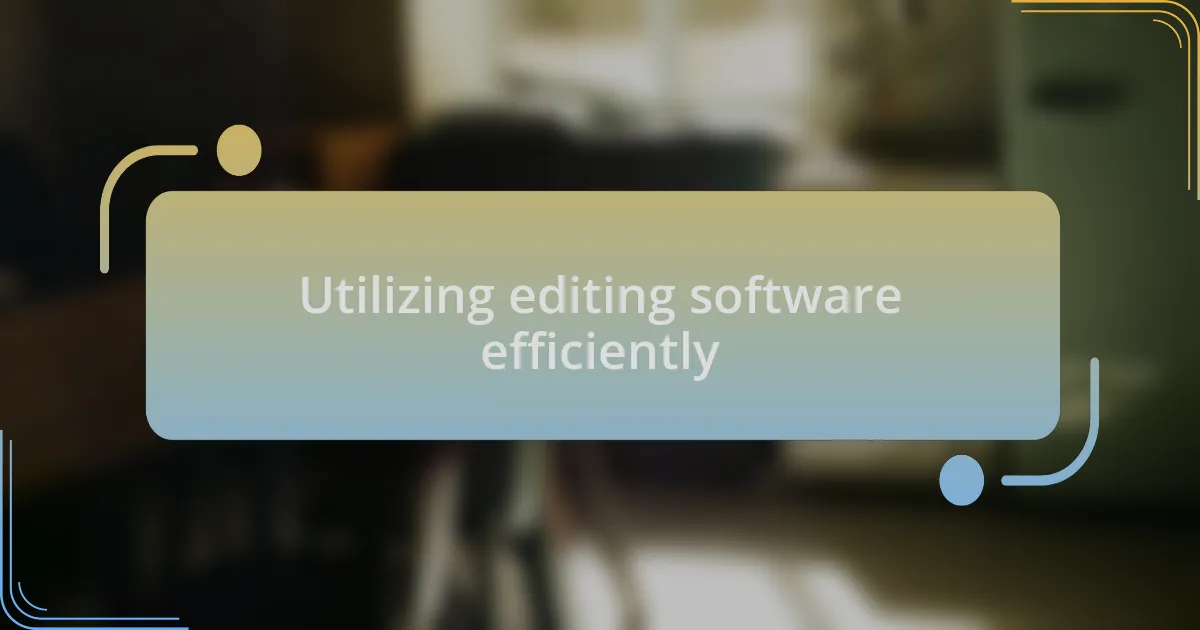
Utilizing editing software efficiently
Editing software can be a real game-changer in achieving seamless transitions in film production. I’ve often found myself lost in the sea of editing timelines, but learning keyboard shortcuts has drastically sped up my workflow. Have you ever tried to do the same? It’s incredible how just a few keystrokes can save you significant time, allowing you to focus on the creative aspects instead of getting bogged down by technical details.
Another crucial aspect is organizing your media files within the software. I once worked on a project that became chaotic due to poorly labeled clips. It was a nightmare! After that experience, I made it a habit to categorize and label everything meticulously. Now, I always ask myself: how can I make it easier to find what I need? This little practice has saved me hours of searching and allowed for smoother collaboration with my team, who can quickly access the footage they need.
Finally, taking the time to regularly review and learn new features of the software ensures that I make the most of its capabilities. There was a time when I figured out a trick for color grading that elevated the entire project’s aesthetic. Discovering these hidden gems can often feel like uncovering treasure. Isn’t it exciting to think about how mastering these tools can transform your storytelling?
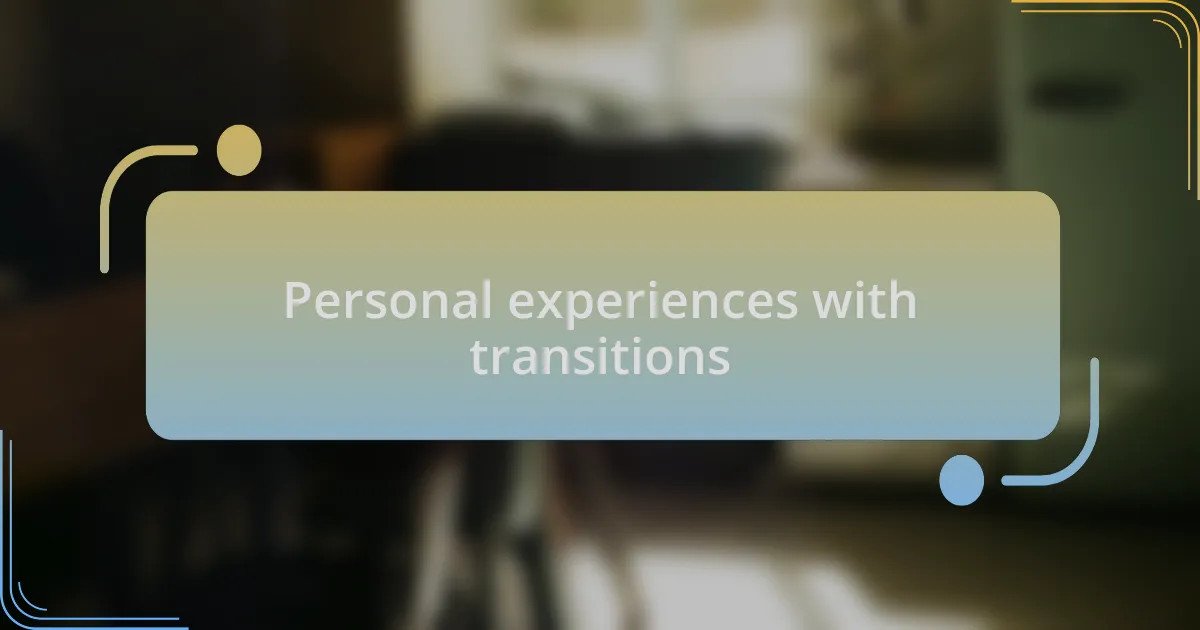
Personal experiences with transitions
When I reflect on my experiences, I remember a crucial moment while working on a short film. We were transitioning from a dramatic scene to a lighter one, and I felt the pressure to get it just right. I decided to use a slow crossfade instead of a hard cut, and the way the mood shifted was magical. Have you ever experienced how a simple change can elevate a moment? That taught me the power of thoughtful transitions.
On another project, I found myself grappling with a tight deadline, which added stress to the editing process. I initially rushed through transitions, resulting in disjointed storytelling. After receiving feedback, I revisited those edits, taking extra care to craft more fluid transitions. This taught me that even amidst chaos, taking a step back is vital. How often do we prioritize speed over quality? It’s a balancing act that all filmmakers face.
Lastly, I recall a time when I experimented with sound design to enhance transitions. I layered ambient sounds to segue between scenes, creating continuity that brought the audience along with us. I remember the joy I felt when viewers remarked on how immersive that experience was. Have you ever thought about how sound can shape the visual journey? It’s these moments of experimentation that make transitions not just functional but also an integral part of the storytelling process.
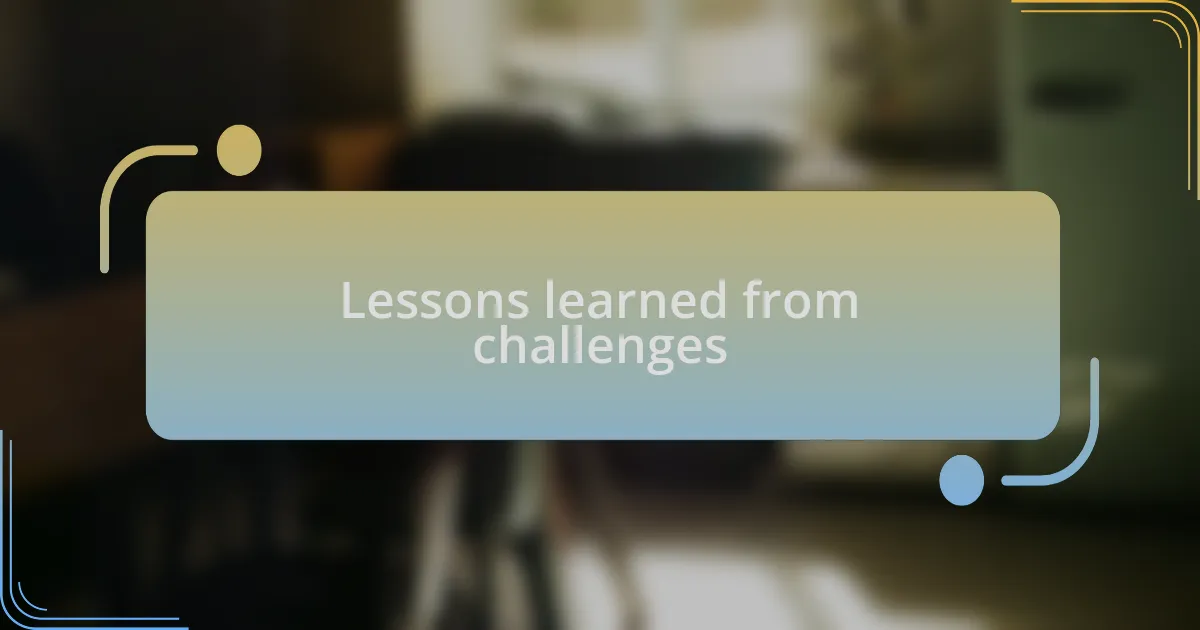
Lessons learned from challenges
When I faced a significant technical setback midway through a production, I learned the importance of adaptability. Our main camera failed just before a critical scene. In that moment, I had to think quickly and decided to use a handheld camera instead. That unexpected choice not only salvaged the shoot but also added an energy to the scene that I hadn’t anticipated. Have you ever found that obstacles can lead to surprising creative breakthroughs?
Another noteworthy lesson came from a tense moment during a film festival screening. We had not prepped a proper transition from one film to another, leaving the audience confused. It was a valuable realization that planning is essential, even for the smallest details. I now approach every project with a checklist, ensuring that even transitions are smooth and thoughtful. It’s a simple step that can greatly enhance audience engagement. Have you considered how meticulous planning could elevate your work?
Finally, I remember a challenging review from a mentor that stung but ultimately shaped my approach. They pointed out that some transitions felt forced and disconnected from the narrative. Initially defensive, I later revisited the feedback with an open mind, realizing they were right. This taught me to embrace constructive criticism and see it as a tool for growth. How often do we hesitate to accept feedback, fearing it might challenge our creative vision? I’ve learned that this discomfort often paves the way for our best work.